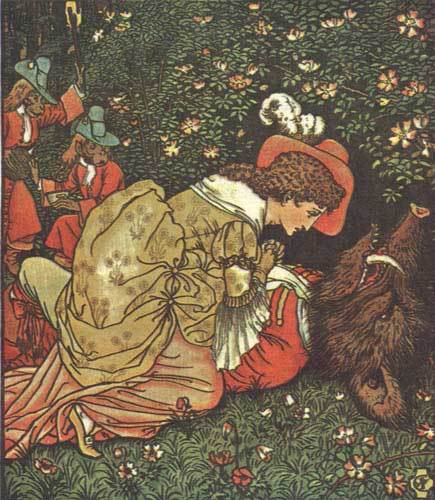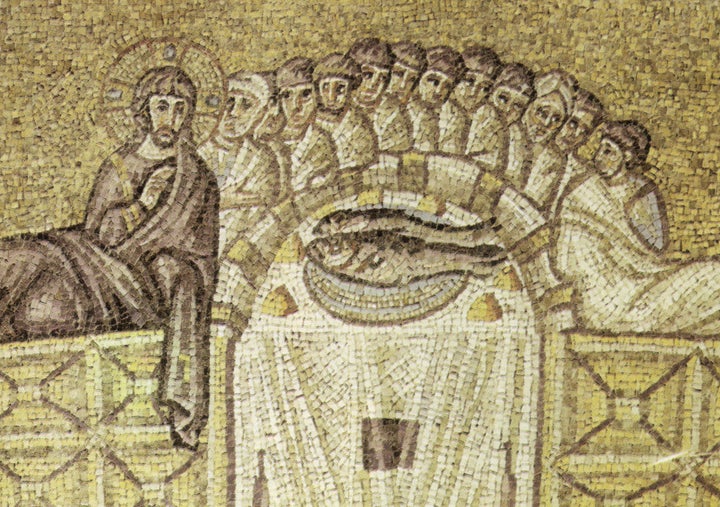
Illustration for Beauty and the Beast. London: George Routledge and Sons, 1874.
“How Long Must This Go On?”
This month’s news that Beauty and the Beast would include a “gay” character was both surprising and exciting. Many in the LGBTQ+ community have long been waiting for a Someday-My-Prince(ss)-Will-Come moment.
This anticipation is part of the reason that concepts like Joey Graceffa’s “Don’t Wait” video play so well with the queer community. They tap into the desires of generations of the LGBTQ+ community to see characters like themselves find their “Happily Ever After.”
Apparently, the community will have to wait a bit longer for that.
Like Rachel Maddow’s release of Trump’s tax returns this week, the queerness of Beauty and the Beast does not live up to the hype surrounding it. And, as I left the theater, I realized that the defining of LeFou as “gay” had undermined my experience of the movie as a whole. The movie was an enchanting and dazzling spectacle, but due to the discussion surrounding it, the “exclusively gay moment” was underwhelming, and it distracted from the beauty of Bill Condon’s creation.
“Something There”?
For those familiar with the discussion, two points will strike you about the film’s queerness.
First, it is fleeting.
Seriously.
If you blink, you will miss it.
Second, the so-called “exclusively gay moment” is not inherently “gay.” It consists of two men dancing together and smiling at one another. Only under a fragile, Gaston-esque definition of masculinity does such an act even read as queer. In fact, in some Western traditions, like Ultra-orthodox Judaism, dancing with your own sex is preferable in certain settings to dancing with members of the opposite sex.
Additionally, examining Christian traditions, you will be hard put to find a biblical text which would condemn this “gay moment.” In fact, you will find the opposite. Early Christianity was more comfortable with displays of affection between members of the same sex than modern Christianity. Thus, Paul told his followers to greet one another with a “holy kiss” (Rom. 16:16) and one of the disciples is depicted as reclining against Jesus on a kline (dining couch, John 13:23).

Last Supper in Basilica of Sant'Apollinare Nuovo .
“The Mob Song”
If the movie carries nothing inherently “gay” or “sinful,” why are people like Franklin Graham raising hullabaloo?
The central issue is one of labels.
Ironically, those involved with the movie seem to have missed one of the central points of the film: the effect of labels. The film questions the legitimacy of labels, from the opening query, “For who could learn to love a beast?” to the Prince’s roar, “I am not a beast!” It shows the power of labels through Gaston’s manipulation of the villagers to attack the castle, and it shows the problem of labels by flipping the idea of what constitutes a “beast.”
Unfortunately, in the discourse around the film, “gay” has proven to have the same powers as “beast.” This point is shown in the timing of the boycott movement: it preceded the release of the movie. Graham posted concerning the queering of the film two weeks prior to its release with no real idea of the film’s actual content. His and others’ actions were reactionary to a label. For social conservatives, in reinterpreting LeFou as “gay,” the character became something menacing. Thus, they sallied forth with their torches and pitchforks, urged by conservative leaders to “protect” their children from their unfounded fears.
“Transformation”
The labeling of LeFou also requires the LGBTQ+ community and their allies to reasses him, and he does not fare too well under such scrutiny.
In retrospect, nothing is inherently wrong with Josh Gad’s performance. The character is similar to his other well-known characters such as Olaf in Frozen or Elder Cunningham in The Book of Mormon, and his performance of Beauty and the Beast’s classic songs are, at times, delightful. In many ways, his is a charming tribute to the animated version of the character and would have been satisfactory as such.
However, rereading LeFou as “gay” necessarily changes his reception. What were adorable antics in Gad’s asexual talking snowman do not play quite as well when they are translated into Disney’s first “gay” main character. Instead, they are transformed into gay stereotypes performed for a laugh by a heterosexual man for a largely heterosexual audience. Despite Condon’s own gayness, the queerness of LeFou does not feel like it was written for the LGBTQ+ community. Instead, it was encoded for a heterosexual gaze.
This fact is no more apparent than in LeFou’s own queer visibility. By even the most generous readings of the performance, LeFou is in the closet. A queer character written for a queer audience should have no need to hide his identity. Likewise, as Condon has interpreted the character, he plays into the tragic caricature of queer individuals pining away after the unattainable straight object of their affections. This idea not only recapitulates heterosexual preconceptions of queerness but also ties into and confirms their fears about homosexuality.
Reprise: “How Long Must This Go On”
Don’t get me wrong. In a Disney-verse where the true “magic” of the “Magic Kingdom” is how everyone is neatly cisgender and heteronormative (and, until recently, white), even caricatured tokenism is welcomed as visibility. We should celebrate the fact that the next generation has a queer character to look to and thank those who made this possible.
At the same time, the character deserves to be critiqued. What is the impact of the fact that the only character that queer children have to look to is a character named “The Fool”? What does this tell them about themselves and their queerness?
Although I adored the movie overall, part of my frustration with it is that I had hoped for more out of Condon’s “exclusively gay moment.” Instead, I found myself left wondering how long the LGBTQ+ community must wait to see a truly authentic performance of queerness by a main character in a Disney film.
